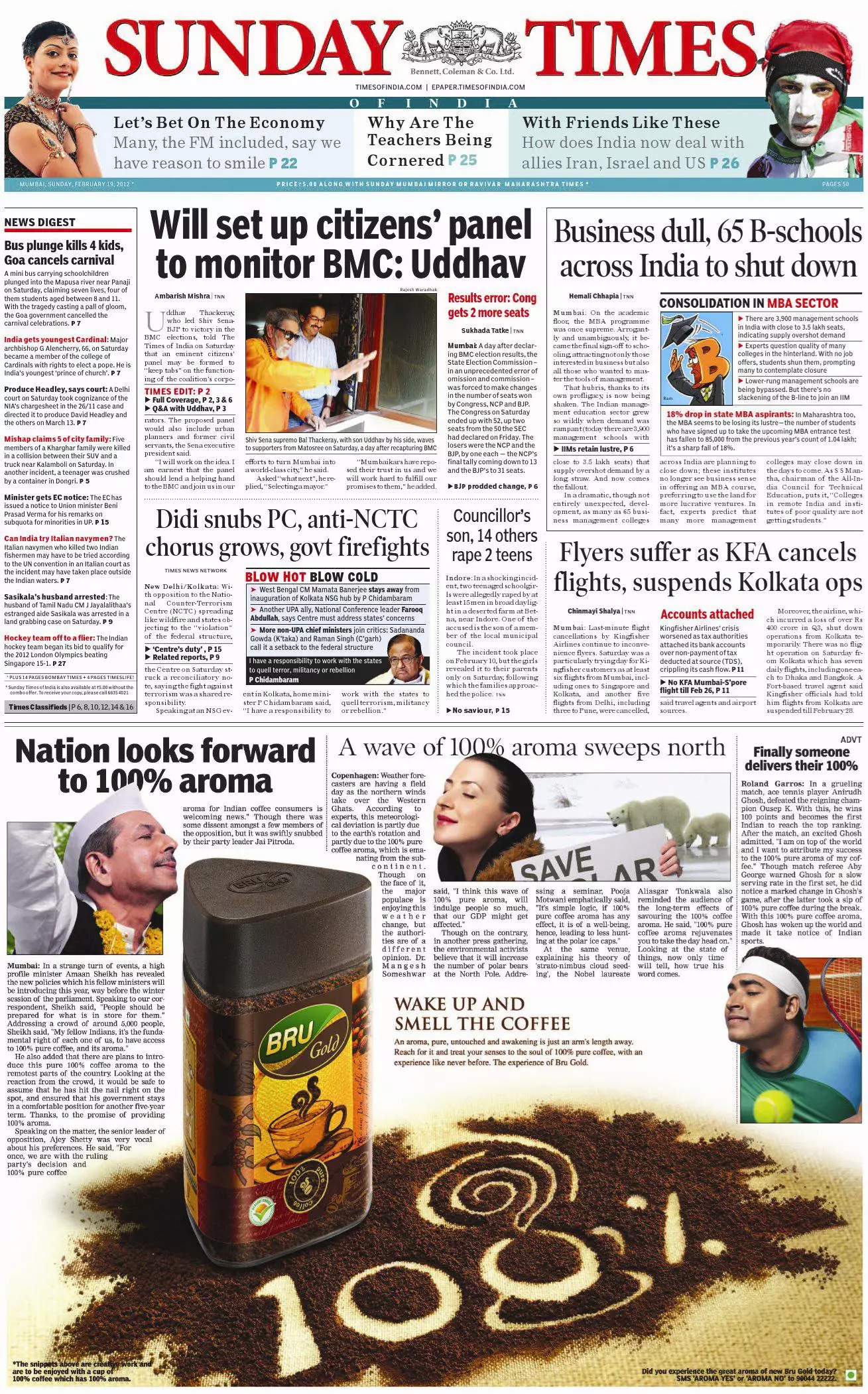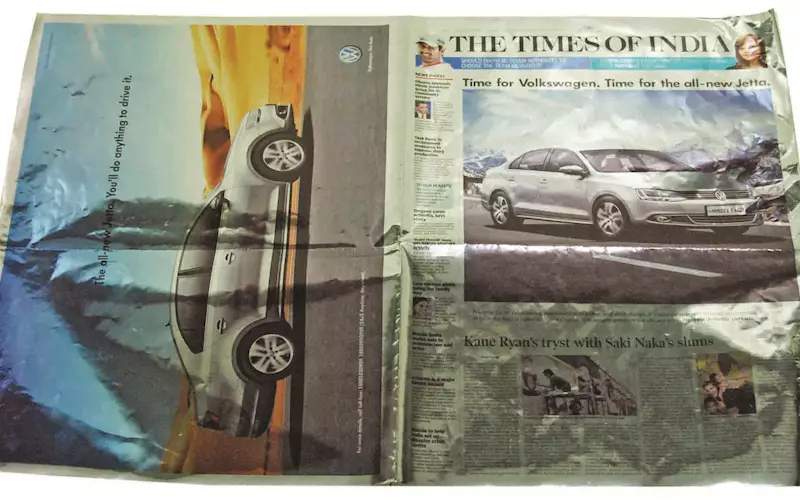The newspaper industry has evolved, Rushikesh Aravkar and Anand Srinivasan look at the newspaper print innovations and scrutinise the samples submitted for PrintWeek India Awards.
As the print master Purnendu Sen recalls the genesis of Indian newspapers, he says that you could not hold a newspaper without dirtying your hands; the rub resistance of ink was very poor. Today, whether it is print quality or print innovations, Indian newspaper has walked many miles ahead to deliver innovations that can grab the eyeballs of the masses.
Print innovations with newspaper are an effective way for the advertisers to tap their prospective customers. This was evident when The Times of India’s Delhi, Mumbai, Pune, Bengaluru and Chennai editions, carried a shining silver false cover printed on a special coated high gloss paper with the Volkswagen Jetta advertisement in its daily dated 29 August, 2011.

Sunday TOI scented with coffee aroma
On 19 February 2012, readers of the Sunday Times of India in Mumbai, New Delhi and Bengaluru were greeted with the aroma of fresh coffee, as part of an innovation by Hindustan Unilever for its coffee brand, Bru Gold. While making his presentation during the PWI Conclave held in August, last year, Bharat Kapadia of ideas@BharatKapadia.com, who conceptualised this ad, said that advertisers and publishers need to think beyond square centimeters. “Collective power of print provides readers with a ‘real touch’ experience as they are the real consumers. Every new fragrance is fresh and can create a new experience. It gave the product an appeal and enhance brand identity,” he says.
Interestingly, in 2010, Hindi daily Dainik Bhaskar published a scented newspaper which carried the fragrance of colours used in Holi. A similar attempt was made last year with Kewada scent.
The representative at Dainik Bhaskar, says, “The difference is in the perfume we used, it is water-based and not oil-based. Oil-based perfumes change the drying property of ink and are slightly toxic in nature. There are a limited choice of fragrances, as new ones cannot be developed easily using oil-based fragrance.”
He adds, “We developed a new fragrance, which was non-toxic in nature and developed by organic components and methods, which was named ‘Green Earth’. What we did was a simple drip arrangement on top of folder-former and right quantities of droplets were released on the streaming newspaper going in the folder.”
In the past, ‘scratch-n-sniff’ had been the only way the sense of smell was addressed in print but it had several limitations. A patch containing tiny bubbles encapsulating aroma chemical was stuck as an additional operation. However, time and cost did not permit its execution in newspapers. Also, when one scratches the patch, a very small quantity of aroma is released, which lasted for a very short time. With this new technique, the reader can smell the fragrance, without having to scratch, as the whole newspaper spreads the aroma.
In another instance, Dainik Bhaskar changed the headline colour to red in order to match the theme of product launch for Redd Mobility devices. According to the Dainik Bhaskar, the challenge in print was to maintain the evenness of red colour in all pages carrying red headlines across all 14 print locations in Rajasthan. Similar campaign for Volkswagen, was implemented by The Times of India in its 31 March 2011 edition. The false cover said - Think Blue, and the headlines were changed from black to blue. It was presumed that this was to honour men in blue’s (the Indian cricket team) win over Pakistan in the then ongoing ICC Cricket World Cup. Later, the readers realised that it was an advertisement of the Volkswagen Passat.

Dainik Jagran: PrintWeek India Newspaper Printer of the Year 2012
Dainik Bhaskar also boasts of scratch innovation on newspaper, which was delivered on 29 September 2011. “Various options were evaluated to apply scratch ink on the newsprint, but none matched the desired speed and time frame. After many experiments, we closed on PVC-based sticker with two coats of water-based white and silver ink printed on it using flexo process and die-cutting the stickers without UV curing.” The other challenge was printing the variable data, which hides under the sticker. “We printed the variable matter in 10% screen so that it gets hidden under the silver sticker.” The application was a mammoth task, with approximately 3,60,000 copies to be pasted with stickers within 12 hours.
The English daily Mid-Day, on 4 January 2011, was delivered in an envelope, which resembled a big Cadbury Dairy Milk chocolate.
The Times of India and The Hindu, on 21 September 2010, embedded a light-sensitive chip, which announced the arrival of “a perfectly engineered car” – the Vento, when readers opened the newspaper. This talking newspaper was one of the most discussed and blogged innovations in print.
Industry trends
In the middle of all this, we at PrintWeek India got an opportunity to look at the trends in the newspaper market subject to the samples submitted by Indian newspaper manufacturers as entries for PrintWeek India Awards 2012 and 2013.
When we scrutinised 37 samples received from eight award entries in 2012 and 40 samples from ten entries in 2013, one thing is clear: the newspaper segment in India continues to be impressive, inspite of e-newspapers, blogs and other online communications.
For Awards 2012, among 37 samples, 16 were printed on Manugraph presses, while eight used TPH’s Orient press while eight used a KBA press. The Awards 2013, saw print samples printed on a wide range of presses including Manugraph, Orient, KBA, Prakash Offset and Wifag with 20 newspapers printed on Manugraph presses. This shows the dominance of Indian press manufacturers in the newspaper industry.
Interestingly, last year, (2012) all the 37 samples used photopolymer violet plates and majority of them were developed on a Krause platesetter, while others used a Screen CTP platesetter. While this year, though majority of entries opted for violet technology, two entries used thermal technology for platemaking. Kodak’s Trendsetter was used for the thermal plates, while violet plates were developed using Krause. So undoubtedly, it seems that Krause rules the market when it comes to newspaper segment.
Another observation was that the average number of pages per copy seems to have been reduced. Among the 2012 Awards samples, more than 80% of the newspapers had 18-20 pages. Whereas this year, about 50% print samples were in the range of 10-16 pages.
When we looked at the design specifications of the Awards entries, it was observed that Adobe Indesign and QuarkXPress are equally preferred software for designing of newspapers. However, for complex scripts especially Urdu, Inpage is the preferred choice.
The run length varied from as low as 24,000 copies to up to seven lakh copies. This suggests that the possibility of short-run newspapers in India in the near future cannot be ruled out. There is a scope for digital printing of newspapers coming into play. Besides eliminating platemaking and related consumables, it offers lower operating costs and an opportunity for personalised advertising that can be used to launch innovative advertising campaigns and coupons.
The challenges of printing 37 editions across eleven states of India are enormous. More than 55.7 million people read Dainik Jagran. According to the IRS Q1 2012, Dainik Jagran was ranked as the number one Hindi daily with a total readership (TR) of 16,412 million.
Winning the Award for the first time at PrintWeek India Awards 2012, Dainik Jagran, scored in colour consistency, which according to the judges is crucial, particularly for advertising.
The company has been shortlisted for the PrintWeek India Awards 2013 along with ABP, Arun Art Printers, D B Corp and Express Publications (Madurai). The results will be announced on 2 October; at the Grand Hyatt in Santacruz in Mumbai.













 See All
See All